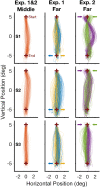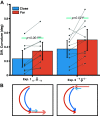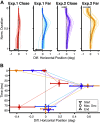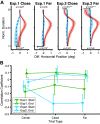Modulation of saccade trajectories during sequential saccades
- PMID: 33471606
- PMCID: PMC7988749
- DOI: 10.1152/jn.00106.2020
Modulation of saccade trajectories during sequential saccades
Abstract
The planning and execution of sequential saccades can overlap in time, and abrupt changes in neural activity in the oculomotor system can alter the normal trajectory of saccades. In this study, we analyzed saccade trajectories to assess the combined programming of sequential saccades. In two separate psychophysical experiments, subjects were instructed to make a sequence of two saccades. The results showed modulation of saccade curvature by the direction and amplitude of both the preceding and following saccade: saccade curvature is modulated in the direction of preceding saccades and away from the direction of following saccades. Moreover, larger preceding and following saccades have stronger effects on curvature. These results support the idea that sequential saccades are programmed concurrently. Finally, the amount of saccade curvature is correlated with the deviation of saccade start and end points, and the time of maximum deviation of saccade trajectories is highly consistent in both experiments. Based on this, we propose a novel benefit for the modulation of saccade trajectories by the oculomotor system: minimizing the saccadic error in sequential saccades.NEW & NOTEWORTHY We show that in saccade sequences, saccade trajectory is modulated in the direction of the preceding saccade and away from the following saccade. The magnitude of this effect is correlated with preceding and following saccade amplitude. This confirms that programming of sequential saccades overlaps. Curvature is also correlated with the deviation of saccade start and end points. Thus, we propose a novel benefit for the modulation of saccade trajectories: minimizing end point error in sequential saccades.
Keywords: curvature; eye movement; saccade; saccade sequence.
Conflict of interest statement
No conflicts of interest, financial or otherwise, are declared by the authors.
Figures







References
-
- Yarbus AL. Eye movements during perception of complex objects. In: Eye Movements and Vision. Boston, MA: Springer US, 1967, p. 171–211. doi:10.1007/978-1-4899-5379-7_8. - DOI
Publication types
MeSH terms
Grants and funding
LinkOut - more resources
Full Text Sources
Other Literature Sources

